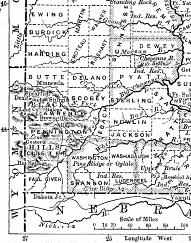|
|
| |
|
S O U T H D A K O T A
Early
Firsts & South Dakota History |
Links | Information Sources
 1888
Map of South Dakota
1888
Map of South Dakota
showing Black Hills region |
Early
Firsts in the Dakota Territory
- The first white men known to have been upon South Dakota soil
were Francois
and Louis Joseph Verendrye, Louis La Londe and A. Miotte in
1742.
- First white resident, probably Pierre Dorion (or Durion) who
seems to have settled at the mouth of James River about 1780.
- First house erected by white men, the Trudeau house, was on
the bank of the Missouri River near White Swan, Charles Mix County,
in November 1794.
- First engagement between US troops and Indians in South Dakota
was the fight of Ensign Prior's men with the Arickara in 1807.
- First permanent white settlement was at Fort Pierre, 1817
by Joseph
La Framboise
- First white woman to come into the region, Pelagie LaBarge,
wife of Joseph LaBarge, captain of the steamboat, "Martha,"
in 1847
- First white child born in South Dakota, Mary Houston Atkinson,
at Fort Pierre, January 8, 1857.
-
The State flag was designed by Ida
M. Anding, legislative librarian in 1909.
Early
South Dakota History
As late as 1794 the Arickara
tribe of Native Americans maintained a hold in the central
part of what is now South Dakota. In approximately 1743
the Sioux tribe began to expand out to the Missouri River eventually
taking complete control of this section.
Dakota, whose Indian name signifies "leagued" aptly
describes her population, drawn from every State of the Union.
Attempts at settlement for agricultural purposes date from 1856,
but the handful of pioneers, confined to the most southerly counties,
were constantly harrassed and frequently driven from their homes
by hostile Indians, so that the increase of population was not
noticeable until after the close of the civil war.
Congress created the Territory of Dakota in 1861, and President
Lincoln, in the same year, appointed Hon.
William Jayne, of Illinois, the first Governor (territorial).
The
national census of 1860 gave Dakota a population of less
than 500; that of 1870, 14,000; of 1880, 135,000,
and give years later the number had increased to 415,610. In 1888
the population was estimated at 640,823.
South Dakota and North Dakota, twin States, were admitted at
the same moment, and no one knowns which proclamation was
first signed. On November 2, 1889, President Benjamin
Harrison was ready to sign the proclamation admitting North and
South Dakota to the Union. He called in Secretary of State James
G. Blaine and a number of gentlemen of North and South Dakota
who were in Washington, together with correspondents of
the newspapers who report White House doings. Mr. Halford, private
secretary took the two proclamations placed them under a newspaper
and shuffled them back and forth until he could not tell which
was first and then, keeping them covered, exposed just enough
of each to permit the president to sign at the bottom. Again shuffling
them he turned them over to Secretary Blaine, who at once telegraphed
the governors of North and South Dakota.
This was the first instance in the history of the US of "twin
states.
North and South Dakota entered the Union at the same moment."
There were 38 states previously in the Union; North Dakota and
South Dakota are the thirty-ninth and fortieth, but which takes
precedence can never be known.
1893 - Chicago World's Fair Exhibit: Mammoth Crystal Cave.
Horticultural Building -- Reproduction of the mammoth crystal
cave situated near the city of Deadwood, S.D.
South
Dakota Maps - old and new
Other South
Dakota Links
History
of South Dakota, by Robinson, Doane, 1856-1946. Internet Archive,
1904 | Volume
1 | Volume
2 |
History
of Dakota Territory, by Kingsbury, George Washington, 1837-; Smith,
George Martin, 1847-1920, Internet Archive, Published 1915l |
Volume
1 | Volume
2 | Volume
3 | Volume
4 Biographical |
South
Dakota Timeline - from World Atlas
The
Early History of the Dakotas ("The Dakota Metropolis)
-
May 1891 from the New England Magazine - Cornell Online Library
Dakota
- the History of the Dakota Territory - Harper's new
monthly magazine, 1889, Cornell Online Library
South
Dakota History & Genealogy - USGennet
South
Dakota Fast Facts & Trivia
"Pa-ha-sa-pah,
or, The Black Hills of South Dakota," by Peter Rosen
- 1895 (online book, Google Books)
"Geological
map of the Black Hills of South Dakota & Wyoming,"
by Samuel Scott - 1897 (Google Books)
Information
Sources
1. Doane Robinson's encyclopedia of South Dakota, Pierre: The author,
1925, 1004 pgs.
2. Harper's new monthly magazine, Volume 78, Issue 463, December
1888
3. Manufacturer and builder: The Exhibits at Chicago; New York,
July 1893, pp. 155-156
|
|
|
|
